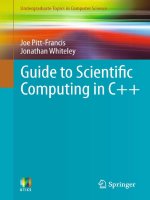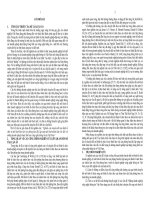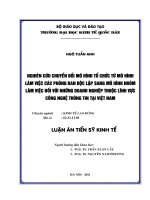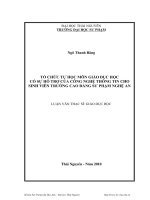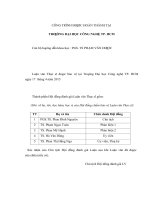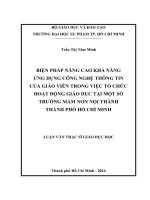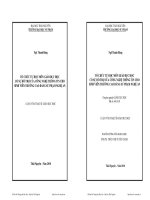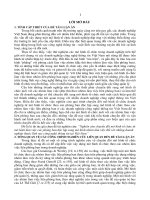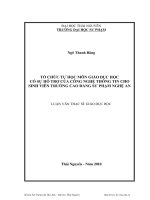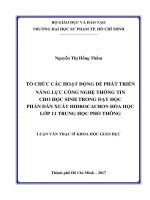Pitt francis, whiteley - guide to scientific computing in c++
Bạn đang xem bản rút gọn của tài liệu. Xem và tải ngay bản đầy đủ của tài liệu tại đây (1.75 MB, 257 trang )
Undergraduate Topics in Computer
Science
Undergraduate Topics in Computer Science (UTiCS) delivers high-quality instructional content for un-
dergraduates studying in all areas of computing and information science. From core foundational and
theoretical material to final-year topics and applications, UTiCS books take a fresh, concise, and mod-
ern approach and are ideal for self-study or for a one- or two-semester course. The texts are all authored
by established experts in their fields, reviewed by an international advisory board, and contain numer-
ous examples and problems. Many include fully worked solutions.
For further volumes:
/>Joe Pitt-Francis
r
Jonathan Whiteley
Guide to Scientific
Computing in C++
Dr. Joe Pitt-Francis
Department of Computer Science
University of Oxford
Oxford, UK
Dr. Jonathan Whiteley
Department of Computer Science
University of Oxford
Oxford, UK
Series editor
Ian Mackie
Advisory board
Samson Abramsky, University of Oxford, Oxford, UK
Karin Breitman, Pontifical Catholic University of Rio de Janeiro, Rio de Janeiro, Brazil
Chris Hankin, Imperial College London, London, UK
Dexter Kozen, Cornell University, Ithaca, USA
Andrew Pitts, University of Cambridge, Cambridge, UK
Hanne Riis Nielson, Technical University of Denmark, Kongens Lyngby, Denmark
Steven Skiena, Stony Brook University, Stony Brook, USA
Iain Stewart, University of Durham, Durham, UK
ISSN 1863-7310 Undergraduate Topics in Computer Science
ISBN 978-1-4471-2735-2 e-ISBN 978-1-4471-2736-9
DOI 10.1007/978-1-4471-2736-9
Springer London Dordrecht Heidelberg New York
British Library Cataloguing in Publication Data
A catalogue record for this book is available from the British Library
Library of Congress Control Number: 2012931858
© Springer-Verlag London Limited 2012
Apart from any fair dealing for the purposes of research or private study, or criticism or review, as per-
mitted under the Copyright, Designs and Patents Act 1988, this publication may only be reproduced,
stored or transmitted, in any form or by any means, with the prior permission in writing of the publish-
ers, or in the case of reprographic reproduction in accordance with the terms of licenses issued by the
Copyright Licensing Agency. Enquiries concerning reproduction outside those terms should be sent to
the publishers.
The use of registered names, trademarks, etc., in this publication does not imply, even in the absence of a
specific statement, that such names are exempt from the relevant laws and regulations and therefore free
for general use.
The publisher makes no representation, express or implied, with regard to the accuracy of the information
contained in this book and cannot accept any legal responsibility or liability for any errors or omissions
that may be made.
Printed on acid-free paper
Springer is part of Springer Science+Business Media (www.springer.com)
Preface
Many books have been written on the C++ programming language, varying across
a spectrum from the very practical to the very theoretical. This book certainly lies
at the practical end of this spectrum, and has a particular focus for the practical
treatment of this language: scientific computing.
Traditionally, Fortran and M
ATLAB®
1
have been the languages of choice for
scientific computing applications. The recent development of complex mathemati-
cal models—in fields as diverse as biology, finance, and materials science, to name
but a few—has driven a need for software packages that allow computational sim-
ulations based on these models. The complexity of the underlying models, together
with the need to exchange code between coworkers, has motivated programmers to
develop object-oriented code (often written in C++) for these simulation packages.
The computational demands of these simulations may require software to be writ-
ten for parallel computing facilities, typically using the Message Passing Interface
(MPI). The need to train programmers in the skills to program applications such as
these led to the development of a graduate level course C++ for Scientific Comput-
ing, taught by the authors of this book, at the University of Oxford.
This book provides a guide to C++ programming in scientific computing. In
contrast to many other books on C++, features of the language are demonstrated
mainly using examples drawn from scientific computing. Object-orientation is first
mentioned in Chap. 1 where we briefly describe what this phrase—and other re-
lated terms such as inheritance—mean, before postponing any further discussion
of object-orientation or related topics until Chap. 6. In the intervening chapters un-
til object-orientation reappears, we present what is best described as “procedural
programming in C++”, covering variables, flow of control, input and output, point-
ers (including dynamic allocation of memory), functions and reference variables.
Armed with this grounding in C++ we then introduce classes in Chaps. 6 and 7.In
these two chapters, where the main features of object-orientation are showcased, we
initially, for the sake of clarity, abandon our principle of using examples drawn from
scientific computing. Once the topics have been presented however, we resume our
strategy of demonstrating concepts through scientific computing examples. More
advanced C++ features such as templates and exceptions are introduced in Chaps. 8
and 9. Having introduced the features of C++ required for scientific computing, the
1
MATLAB is a registered trademark of The MathWorks, Inc.
v
vi Preface
remainder of the book focuses on the application of these features. In Chap. 10,we
begin to develop a collection of classes for linear algebra calculations: these classes
are then developed further in the exercises at the end of this chapter. Chapter 11
presents an introduction to parallel computing using MPI. Finally, in Chap. 12,we
discuss how an object-oriented library for solving second order differential equa-
tions may be constructed. The importance of a clear programming style to minimise
the introduction of errors into code is stressed throughout the book.
This book is aimed at programmers of all levels of expertise who wish to write
scientific computing programs in C++. Experience with a computer to the level
where files can be stored and edited is expected. A basic knowledge of mathematics,
such as operations between vectors and matrices, and the Newton–Raphson method
for finding the roots of nonlinear equations would be an advantage.
The material presented here has been enhanced significantly by discussions about
C++ with colleagues, too numerous to list here, in the Department of Computer Sci-
ence at the University of Oxford. A special mention must, however, be made of the
Chaste
2
programming team: particular gratitude should be expressed to Jonathan
Cooper for readily sharing with us his impressively wide and deep knowledge of
the C++ language. Other members of the team who have significantly helped clarify
our thoughts on the C++ language are Miguel Bernabeu, James Osborne, Pras Path-
manathan and James Southern. We should also thank students from both the M.Sc.
in Mathematical Modelling and Scientific Computing and the Doctoral Training
Centres at the University of Oxford for unwittingly aiding our understanding of the
language through asking pertinent questions.
Finally, it is always important to remember—especially when debugging a par-
ticularly tiresome code—that there is far more to life than C++ programming for
scientific computing. We would both like to thank our families for their love and
support, especially during the writing of this book.
Joe Pitt-Francis
Jonathan Whiteley
Oxford, UK
2
The Cancer, Heart And Soft Tissue Environment (Chaste) is an object-oriented package, written
in C++, for simulations in the field of biology. More details on this package may be found at
/>Contents
1 Getting Started 1
1.1 A Brief Introduction to C++ . . 1
1.1.1 C++is“Object-Oriented” 1
1.1.2 Why You Should Write Scientific Programs in C++ 2
1.1.3 Why You Should Not Write Scientific Programs in C++ . . 4
1.1.4 Scope of This Book . . 4
1.2 AFirstC++Program 5
1.3 Compiling a C++ Program . . . 6
1.3.1 IntegratedDevelopmentEnvironments 6
1.3.2 Compiling at the Command Line 7
1.3.3 CompilerFlags 8
1.4 Variables 10
1.4.1 BasicNumericalVariables 10
1.4.2 OtherNumericalVariables 12
1.4.3 MathematicalOperationsonNumericalVariables 13
1.4.4 DivisionofIntegers 15
1.4.5 Arrays 16
1.4.6 ASCIICharacters 17
1.4.7 BooleanVariables 17
1.4.8 Strings 18
1.5 Simple Input and Output 19
1.5.1 BasicConsoleOutput 19
1.5.2 Keyboard Input 20
1.6 The assert Statement 21
1.7 Tips: Debugging Code 22
1.8 Exercises 23
2 Flow of Control 25
2.1 The if Statement 25
2.1.1 A Single if Statement 26
2.1.2 Example: Code for a Single if Statement 27
2.1.3 if–else Statements 27
2.1.4 Multiple if Statements 27
2.1.5 Nested if Statements 28
vii
viii Contents
2.1.6 BooleanVariables 28
2.2 Logical and Relational Operators 29
2.3 The while Statement 30
2.4 Loops Using the for Statement 32
2.4.1 Example: Calculating the Scalar Product of Two Vectors . . 34
2.5 The switch Statement 34
2.6 Tips: Loops and Branches . . . 35
2.6.1 Tip1:ACommonNoviceCodingError 35
2.6.2 Tip2:CountingfromZero 36
2.6.3 Tip 3: Equality Versus Assignment 37
2.6.4 Tip 4: Never Ending while Loops 38
2.6.5 Tip5:ComparingTwoFloatingPointNumbers 39
2.7 Exercises 39
3 File Input and Output 43
3.1 RedirectingConsoleOutputtoFile 43
3.2 Writing to File 44
3.2.1 Setting the Precision of the Output 46
3.3 Reading from File 47
3.4 Reading from the Command Line 49
3.5 Tips: Controlling Output Format 50
3.6 Exercises 51
4 Pointers 55
4.1 PointersandtheComputer’sMemory 55
4.1.1 Addresses 55
4.1.2 PointerVariables 56
4.1.3 ExampleUseofPointers 56
4.1.4 WarningsontheUseofPointers 57
4.2 Dynamic Allocation of Memory for Arrays 58
4.2.1 Vectors 59
4.2.2 Matrices 60
4.2.3 Irregularly Sized Matrices 61
4.3 Tips:Pointers 62
4.3.1 Tip1:PointerAliasing 62
4.3.2 Tip 2: Safe Dynamic Allocation 63
4.3.3 Tip 3: Every new Has a delete 63
4.4 Exercises 64
5 Blocks, Functions and Reference Variables 65
5.1 Blocks . . . 65
5.2 Functions . . 66
5.2.1 Simple Functions . . . 66
5.2.2 Returning Pointer Variables from a Function 69
5.2.3 Use of Pointers as Function Arguments . . 70
5.2.4 Sending Arrays to Functions 71
Contents ix
5.2.5 Example: A Function to Calculate the Scalar Product of
TwoVectors 73
5.3 Reference Variables 74
5.4 Default Values for Function Arguments 75
5.5 Function Overloading 76
5.6 Declaring Functions Without Prototypes 78
5.7 Function Pointers 79
5.8 Recursive Functions 81
5.9 Modules . . 82
5.10 Tips: Code Documentation . . 83
5.11Exercises 85
6 An Introduction to Classes 87
6.1 The Raison d’Être forClasses 87
6.1.1 Problems That May Arise When Using Modules 88
6.1.2 Abstraction, Encapsulation and Modularity Properties of
Classes 88
6.2 A First Example Simple Class: A Class of Books . 89
6.2.1 Basic Features of Classes 89
6.2.2 Header Files 91
6.2.3 Setting and Accessing Variables 92
6.2.4 Compiling Multiple Files 94
6.2.5 Access Privileges . . . 96
6.2.6 Including Function Implementations in Header Files 97
6.2.7 ConstructorsandDestructors 98
6.2.8 PointerstoClasses 103
6.3 The friend Keyword 103
6.4 A Second Example Class: A Class of Complex Numbers 105
6.4.1 Operator Overloading . 105
6.4.2 TheClassofComplexNumbers 106
6.5 Some Additional Remarks on Operator Overloading 112
6.6 Tips: Coding to a Standard . . . 112
6.7 Exercises 114
7 Inheritance and Derived Classes 117
7.1 Inheritance, Extensibility and Polymorphism . . . 117
7.2 Example: A Class of E-books Derived from a Class of Books . . . 118
7.3 Access Privileges for Derived Classes 120
7.4 ClassesDerivedfromDerivedClasses 121
7.5 Run-TimePolymorphism 122
7.6 TheAbstractClassPattern 124
7.7 Tips: Using a Debugger 126
7.8 Exercises 127
8 Templates 131
8.1 TemplatestoControlDimensionsandVerifySizes 131
x Contents
8.2 TemplatesforPolymorphism 133
8.3 A Brief Survey of the Standard Template Library . 134
8.3.1 Vectors 134
8.3.2 Sets 137
8.4 Tips:TemplateCompilation 139
8.5 Exercises 140
9 Errors and Exceptions 141
9.1 Preconditions 142
9.1.1 Example: Two Implementations of a Graphics Function . . 142
9.2 ThreeLevelsofErrors 143
9.3 Introducing the Exception . . . 144
9.4 Using Exceptions 145
9.5 Tips:Test-DrivenDevelopment 146
9.6 Exercises 147
10 Developing Classes for Linear Algebra Calculations 151
10.1 Requirements of the Linear Algebra Classes . . . 151
10.2ConstructorsandDestructors 156
10.2.1TheDefaultConstructor 156
10.2.2TheCopyConstructor 156
10.2.3 A Specialised Constructor 157
10.2.4Destructor 157
10.3AccessingPrivateClassMembers 157
10.3.1AccessingtheSizeofaVector 158
10.3.2 Overloading the Square Bracket Operator . 158
10.3.3 Read-Only Access to Vector Entries 158
10.3.4 Overloading the Round Bracket Operator . 158
10.4 Operator Overloading for Vector Operations . . . 158
10.4.1TheAssignmentOperator 159
10.4.2UnaryOperators 159
10.4.3BinaryOperators 159
10.5 Functions . . 159
10.5.1 Members Versus Friends 159
10.6 Tips: Memory Debugging Tools 160
10.7Exercises 161
11 An Introduction to Parallel Programming Using MPI 165
11.1DistributedMemoryArchitectures 165
11.2 Installing MPI 167
11.3AFirstProgramUsingMPI 167
11.3.1 Essential MPI Functions 168
11.3.2 Compiling and Running MPI Code 169
11.4BasicMPICommunication 171
11.4.1Point-to-PointCommunication 171
11.4.2CollectiveCommunication 174
Contents xi
11.5ExampleMPIApplications 180
11.5.1SummationofSeries 180
11.5.2 Parallel Linear Algebra 182
11.6 Tips: Debugging a Parallel Program 186
11.6.1Tip1:MakeanAbstractProgram 186
11.6.2Tip2:DatatypeMismatch 186
11.6.3 Tip 3: Intermittent Deadlock 187
11.6.4Tip4:AlmostCollectiveCommunication 187
11.7Exercises 188
12 Designing Object-Oriented Numerical Libraries 193
12.1DevelopingtheLibraryforOrdinaryDifferentialEquations 194
12.1.1 Model Problems 194
12.1.2 Finite Difference Approximation to Derivatives 195
12.1.3 Application of Finite Difference Methods to Boundary
ValueProblems 197
12.1.4 Concluding Remarks on Boundary Value Problems in One
Dimension 199
12.2 Designing a Library for Solving Boundary Value Problems 200
12.2.1 The Class SecondOrderOde 200
12.2.2 The Class BoundaryConditions 201
12.2.3 The Class FiniteDifferenceGrid 202
12.2.4 The Class BvpOde 203
12.2.5 Using the Class BvpOde 205
12.3 Extending the Library to Two Dimensions 205
12.3.1 Model Problem for Two Dimensions . . . 207
12.3.2 Finite Difference Methods for Boundary Value Problems
inTwoDimensions 207
12.3.3 Setting Up the Linear System for the Model Problem . . . 209
12.3.4 Developing the Classes Required 210
12.4 Tips: Using Well-Written Libraries 210
12.5Exercises 211
Appendix A Linear Algebra 213
A.1 VectorsandMatrices 213
A.1.1 OperationsBetweenVectorsandMatrices 214
A.1.2 The Scalar Product of Two Vectors 215
A.1.3 The Determinant and the Inverse of a Matrix 215
A.1.4 EigenvaluesandEigenvectorsofaMatrix 216
A.1.5 VectorandMatrixNorms 216
A.2 Systems of Linear Equations . 217
A.2.1 GaussianElimination 217
A.2.2 TheThomasAlgorithm 222
A.2.3 TheConjugateGradientMethod 222
xii Contents
Appendix B Other Programming Constructs You Might Meet 225
B.1 CStyleOutput 225
B.2 C Style Dynamic Memory Allocation 226
B.3 Ternary ?: Operator 226
B.4 Using Namespace 227
B.5 Structures 228
B.6 Multiple Inheritance 228
B.7 Class Initialisers 229
Appendix C Solutions to Exercises 231
C.1 Matrix and Linear System Classes 231
C.2 ODESolverLibrary 240
Further Reading 245
Mathematical Methods and Linear Algebra 245
C++Programming 245
The Message-Passing Interface (MPI) 245
Index 247
1
Getting Started
In this introductory chapter, you will learn a little bit about the features of C++ in
terms of some of the common “buzzwords” you may have heard about the language,
and in terms of its strengths and weaknesses. You will also learn how to edit, compile
and run your first C++ program. This chapter also includes information on variables
and simple ways of getting data into and out of your programs.
The chapter concludes with tips on how you might, as a novice C++ programmer,
go about debugging your programs. We have included tips with every chapter in
this book. They are presented at an increasing level of sophistication—this should
match your gaining knowledge as you read through the book and attempt some of
the exercises.
1.1 A Brief Introduction to C++
A very large number of programming languages for writing computer software exist.
If one of these programming languages was the most suitable for all purposes, then
it would be expected that everyone would use this language, and all other languages
would eventually become obsolete. This, however, is certainly not the case. It seems
appropriate to begin this book by describing the key features of C++, allowing us
to explain why C++ is a suitable programming language for scientific computing
applications and why it isn’t the only suitable choice of language.
1.1.1 C++ is “Object-Oriented”
You may have heard that C++ is an “object-oriented” language and have wondered
what that means. What marks a language which is object-oriented out from one that
is not? Fundamentally, it is because the basic unit of the language is an object or
class—an entity which brings together related functionality and data. We will probe
the ideas behind objects and classes more deeply in Chap. 6.
J. Pitt-Francis, J. Whiteley, Guide to Scientific Computing in C++,
Undergraduate Topics in Computer Science,
DOI 10.1007/978-1-4471-2736-9_1, © Springer-Verlag London Limited 2012
1
2 1 Getting Started
Many books on C++ start by defining object-orientation more explicitly. If this
book were aimed at a computer science or software engineering audience, then we
would find it necessary to define some specific concepts related to object-orien-
tation. We would need to convince you of the importance of the following concepts.
• Modularity. All the data of a particular object, and the operations that we perform
on this object, are held in one or two files, and can be worked on independently.
• Abstraction. The essential features and functionality of a class are put in one
place and the details of how they work are unimportant to the user of the class.
For example, if you are using a linear system library to solve matrix equations
you should not need to know the precise details of how matrices are laid out in
memory or the exact order that a numerical solver performs its operations. You
should only need to know how to use the functionality of the library.
• Encapsulation. The implementation of an object is kept hidden from the user of
the class. This is not only about clarity (abstracting away the detail). It is also
about preventing the user from accidentally amending internal workings of, for
example, a linear solver, stopping it from working effectively.
• Extensibility. Functionality can be reused with selected parts extended. For ex-
ample, much of the core of a linear solver is in matrix-vector products and scalar
products—this type of functionality need only be implemented once, then other
parts of the program can build on it.
• Polymorphism. The same code can be used for a variety of objects. For example,
we would like to use similar looking C++ code to raise a matrix of complex
numbers to a given power as we would to raise a real number to a given power—
even though the basic arithmetic operations “behind the scenes” are different.
• Inheritance. This, perhaps the most important feature of object-orientation, al-
lows for code reuse, extensibility and polymorphism. For example, a new linear
solver for singular matrix systems will share many of the features of a basic lin-
ear solver. Inheritance allows the new solver to derive functionality from the basic
solver, and then build on this functionality.
We are not going to discuss these terms in any more detail at this time. It is not
that these things are unimportant. Quite the contrary—all these concepts add up to
make C++ a very powerful language. However, we can cover the basics of program-
ming without object-orientation. We will describe classes and objects in Chap. 6
and revisit some of these concepts. Then we can show exactly why inheritance,for
instance, is so powerful when we come to explain it in Chap. 7.
1.1.2 Why You Should Write Scientific Programs in C++
Since you have selected a book with the words “C++” and “Scientific Computing”
in the title, then the chances are that you have decided to start writing your scientific
programs in C++. Perhaps not. Perhaps you are considering your options, or perhaps
the choice of language has been foisted on you.
It is not our place to fight battles about which language is the very best, especially
because the choice of language for a program will often depend on the problem that
is being solved. In the field of numerical scientific programming, there are many
1.1 A Brief Introduction to C++ 3
languages being used, with most scientists opting for MATLAB®,
1
C/C++ or For-
tran.
The first and most compelling reason for using C++ (as well as C and Fortran)
is because they are fast. That is, with careful programming and optimisations, they
can be compiled to a machine code program which is able to use the full power of
the available hardware. Many scripting languages (such as M
ATLAB and Python)
are interpreted languages, meaning that the code which you write is translated to
machine code at run time. Other modern languages (such as Java and C#) com-
pile halfway—to a hardware-independent byte-code which is then interpreted at run
time. Run time interpretation means that some of the computer’s power is spent
on the conversion process and also that it is harder to apply optimisations. Nowa-
days M
ATLAB, Python and Java implementations use clever tricks such as caching
compilation steps and just-in-time compilation to make programs run faster. Nev-
ertheless, these tricks require computational effort and so these languages may not
fully utilise the power of all hardware.
A second reason for using C++ is that there is a wealth of numerical libraries for
scientific computing in C++ and related languages. Lots of numerical algorithms
were established in the 1950s and were then incorporated into software libraries
(such as EISPACK and LINPACK) in the 1970s.
2
If you write your own code using
well-established, well-tested software then you are building on decades of experi-
ence and improvement.
A third reason for choosing to write in C++ is that there is a wide-range of open
source and commercial tools to support you. We used the free GNU compiler tool-
set to test the programs in this book and you can use any C++ compiler to compile
them for your computer. In contrast, if we were distributing M
ATLAB programs,
you would need to have M
ATLAB and a licence installed on your computer because
it is a proprietary product. There are similar open source products (such as GNU
Octave) but there is no guarantee that a M
ATLAB program will produce the same
answer when run in Octave. Because it is closed source, the meaning of a program
can change between versions of M
ATLAB. For example, when just-in-time compila-
tion was introduced in M
ATLAB 7 the operational semantics of the language subtly
changed. This meant that a small minority of M
ATLAB programs which were known
to work well with one version of M
ATLAB could produce incorrect results, errors or
warnings on another version.
A fourth reason for C++ is that it has a flexible memory management model.In
a Java program, some of the system memory is used in the interpretation and you
rely on a garbage collector to tidy up memory which you are no longer using, and
so you may not be able to predict how much memory a program is going to need.
In C++ you can make this prediction, but this is a double-edged sword because you
are also responsible for making sure that memory is managed properly.
1
MATLAB is a registered trademark of The MathWorks, Inc.
2
The original version of MATLAB was written in Fortran and was intended as a simple interface
into parts of the EISPACK and LINPACK Fortran libraries.
4 1 Getting Started
A final reason to program in C++ is that it is an object-oriented language.We
haven’t yet told you what this means exactly, but it is widely held that writing in an
object-oriented style leads to programs which are easier to understand, to extend, to
maintain and to refactor.
1.1.3 Why You Should Not Write Scientific Programs in C++
It is worth stressing that C++ is not the best language for every occasion. Some
people say that other languages may be faster. Many scientific programmers believe
that Fortran will always give the best performance in terms of raw speed and would
reject C++ on the basis that features such as pointer chasing and virtual method
look-up (don’t worry if you haven’t heard of these terms, or don’t know what they
mean—you may never need to!) result in the code being executed at suboptimal
speed. This may have some truth, but the fact that object-orientation leads to greater
readability (as mentioned above) makes it a reasonable compromise language. It can
be a very fast language and it is also a good language for readability.
Sometimes other languages are better for a specialised task. Scripting languages
such as Perl and Python are ideal for text processing and string manipulation. If you
need to sum columns of numbers from files then you could write a C++ program,
but a short, disposable script would be far quicker to implement.
Some languages are better for writing prototype programs or for plotting data.
M
ATLAB excels in the field of rapid prototyping—short programs to quickly explore
some algorithm or phenomenon. To test a particular linear algebra algorithm on a
range of matrices with various sizes and structures would take a few lines of M
AT-
LAB, but in C++ you might have to write several files and compile against someone
else’s libraries. M
ATLAB also has the advantage of a fully-integrated graphical de-
velopment environment, making many programming tasks easy without having to
rely on extra tools. Furthermore, M
ATLAB has an in-built plotting environment, so
if you want to visualise the results of your algorithms quickly M
ATLAB might be
your best choice.
So C++ may not be the best choice of language in every situation. However,
there are many situations in which C++ has the ideal fit for a particular problem.
The discussion above may be enough to convince you that it is worth getting started
with C++.
1.1.4 Scope of This Book
Most C++ programs for scientific computing can be written very effectively by us-
ing only a fraction of the total capabilities of the language. This book focuses on
the aspects of C++ that you are most likely to utilise, or to encounter in other pro-
grammer’s code, for scientific computing applications. When writing your own pro-
grams, you may occasionally need to understand one of the more advanced features
of the language. In the Further Reading section at the end of this book, we direct the
reader to a collection of resources that provide a more comprehensive description of
the whole C++ language [5–8].
1.2 A First C++ Program 5
1.2 A First C++ Program
It is very common to introduce a programming language by using a program that
prints the text “Hello World” to the screen. A simple example of a C++ program
that does this is shown below.
The code in Listing 1.1 illustrates several basic features of C++ programs. In
line 1 of this code, we include the header file iostream. The name iostream
pertains to input and output streaming and is required in any C++ program that
inputs data from the keyboard or outputs data to the console, that is, the screen. The
second feature to note is that there is a section of code that:
• begins with the line of code “int main(int argc, char
*
argv[])”
(line 3 of this code);
• is followed by more code enclosed between curly brackets, { and }; and
• the code within the curly brackets ends with the statement “return 0;”.
The section of the code between curly brackets contains the instructions that we
want the computer to execute. The part of line 3 inside brackets allows us to execute
the code using user-specified arguments: we will postpone a discussion of this func-
tionality until Chap. 3. Note that comments have been inserted into the code in lines
5, 6, 7 and 9 to aid the reading of the code by humans: anything between the com-
ment opener “/
*
” and the comment closer “
*
/”, or any line that starts with “//”is
a comment, and is ignored when the code is converted into an executable, computer
readable file. We have used the extension .cpp for the code below to indicate that
the file HelloWorld.cpp is a C++ program. Choice of this extension is entirely
a matter of personal choice: other authors use the extensions .C, .c++, .cxx or
.cc.
We now focus on the purpose of lines 10 and 12: these lines of code each contain
an instruction to the computer, and are known as statements. Note that all statements
end with a semi-colon. It is sufficient for the time being for the reader to know that
line 10 is the line of code that directs the computer to print the contents within the
Listing 1.1 HelloWorld.cpp
✞
1 #include <iostream>
2
3 int main(int argc, char
*
argv[])
4 {
5
/* This is a comment and will be ignored by the compiler
6
Comments are useful to explain in English what
7
the program does */
8
9
// Print "Hello World" to the screen
10 std::cout << "Hello World\n";
11
12 return 0;
13 }
6 1 Getting Started
quotation marks to the screen. The “\n” denotes a new line, and so the phrase “Hello
World”, followed by a new line, will be printed to the screen. The word cout is a
contraction of console output, that is, printing to the screen.
Theword“int” at the start of line 3 indicates that the last line of the code within
curly brackets will return an integer value. This is carried out using the statement in
line 12 “return 0;”. Returning the value zero indicates to the computer that the
program has reached the end without encountering any problems.
Before moving on to explain how to get your computer to print Hello World
to your screen we pause to discuss some stylistic issues of which you should be
aware. You will see in the listing above that all lines of code within the curly brackets
have been indented. This is not compulsory. However, it is standard practice when
coding to indent these lines: this will become clearer in later chapters when we em-
bed code within more than one set of curly brackets. The number of spaces indented
is entirely for the programmer to decide: all spaces—termed “white space”—are ig-
nored when executing the code above. A final point is that lines in C++ may be as
long as the programmer wishes, and may run over the end of the line in the text ed-
itor used to write your C++ programs. For clarity, it is generally advisable to split a
potentially long line over several lines. We will demonstrate this later when writing
more complex statements.
The code in Listing 1.1 is a correct C++ program for printing the text “Hello
World” to the screen. However, before this program may be executed it must first
be translated into a format that the computer can read: this process is known as
compilation. We now explain what compilation is, and how to do it.
1.3 Compiling a C++ Program
Many readers will have experience of scientific computing in MATLAB.Akeydif-
ference between C++ and M
ATLAB is that a C++ program must be compiled before
it can be executed. There are many different ways that compilation can be performed
which we now discuss.
1.3.1 Integrated Development Environments
As you take your first steps in learning a new programming language, you may not
want to invest a lot of time in installing new software and configuring applications to
help you develop programs. For this reason, we recommend that you begin writing
programs with your favourite text editor and a command line compiler (see the
following Sect. 1.3.2). However, as your programs and projects grow in size you
will need to manage multiple files each containing various parts of the program. This
becomes difficult when the number of files becomes large, and you may spend a lot
of time switching between files in order to look up what you called some function or
argument. At this point in your code development, we would recommend that you
switch to using an Integrated Development Environment (IDE).
1.3 Compiling a C++ Program 7
Examples of IDEs that are available for C++ programmers at the time of writing
include KDevelop and gbuilder for Linux, Microsoft Visual Studio for Windows,
XCode for Mac OS X, and Eclipse. Eclipse is open source, runs on most operat-
ing systems and is well-maintained by a community of developers. Because it was
originally built for developing Java programs, it is necessary to install a “C/C++
development tools plug-in” should it be used for developing C++ programs.
The functionality of various IDEs varies according to their level of sophistication,
but most present the seasoned programmer with several advantages over an old-
school compile at the command line approach. Common features of IDEs are listed
below. Don’t worry if you do not fully understand all the terms used: these will
become clear as you work through this book.
1. A program editor with syntax highlighting such as keyword colouring, automatic
code indentation and identification of illegal programming constructs.
2. Context aware editing, so that you immediately know what functionality is
present in one of your classes as you type its name.
3. Build automation, where your entire project code is managed so that changes to
small parts of a large program only result in small compilation steps. Build au-
tomation is traditionally done with a hand-crafted file known as a Makefile,
which we introduce in Sect. 6.2.4.1. Many IDEs analyse your code for depen-
dencies and then use a Makefile behind the scenes.
4. On-the-fly compilation gives the system the ability to constantly save and com-
pile your program as you write it.
5. “Step through” graphical debugging lets you walk through a program as it runs,
pause it at critical points, and examine the internal state of its variables. (More
information on debuggers is given in Sect. 7.7.)
6. Automatic code generation is particularly useful in IDEs for graphical tool devel-
opment. When the user selects that they want to include a button on a graphical
tool in their program some “boiler plate” code is generated including the func-
tions that are activated when the button is pressed—these are then filled in by the
programmer.
1.3.2 Compiling at the Command Line
When using the Linux operating system,
3
C++ codes may be compiled and executed
at the command line within a terminal window. Many compilers—both open source
and commercially developed—are available. In this book, we assume that the reader
3
If you are working on a Mac operating system, we recommend that you install the Xcode devel-
oper tool-set. This comes complete with a GNU C++ compiler which you can use on the command
line or within the developer environment. If you are working on a Windows operating system,
we recommend that you install MinGW (a minimal environment for using GNU tools within Win-
dows). Alternatively, you may want something more sophisticated built on MinGW such as Cygwin
(a Unix-like environment) or Code::Blocks (an open source windows development environment
containing MinGW and the GNU C++ compiler).
8 1 Getting Started
has access to the GNU gcc compiler. To ensure that this compiler is installed, open
a terminal window and type “which g++” followed by return. Hopefully the com-
puter will respond by reporting the location of this compiler, for example,
✞
$ which g++
/usr/bin/g++
$
If the compiler is not installed, it may be downloaded from />where instructions for installation may also be found.
To compile the code given in Listing 1.1, open a terminal window and create a
directory where code may be saved. Move into this directory, and save the code as
“HelloWorld.cpp”. In the same directory type
✞
g++ -o HelloWorld HelloWorld.cpp
In the command above, g++ tells the computer that we want to use the GNU gcc
compiler for C++. The section of the command “-o HelloWorld” tells the com-
puter that we want to name the executable file “HelloWorld”. The “-o” is known
as the flag that the computer expects will be followed by the executable name, in
this case HelloWorld. The command ends by stating the C++ file that we wish
to compile. This command produces an executable file called HelloWorld .This
executable may be run by typing “./HelloWorld” inside the terminal. Running
this executable will result in the text “Hello World” being printed to the screen inside
the terminal.
If we were to compile the code using the command above, but without the flag
and the executable name, then an executable file would still be produced. A default
name would be allocated to the executable file. For many compilers, this default
executable name is a.out .
1.3.3 Compiler Flags
If we were to attempt to compile a code that was not written using correct C++ syn-
tax, then the compiler would report an error, and would not produce an executable
file. As such, the compiler can be thought of as a helpful tool that has the capability
to perform some validation of the correctness of the code.
Suppose we have written code where a calculation was stored as a variable, but
this variable is never subsequently used. Although this may be written with correct
C++ syntax it is likely that this is an error—we would expect that the result of every
calculation will subsequently be used somewhere in the code, or there would be
no point in performing this calculation. Compilers have the capacity to warn us of
unexpected occurrences such as this by the use of compiler flags. The compilation
command below will warn us of instances such as these.
1.3 Compiling a C++ Program 9
✞
g++ -Wall -o HelloWorld HelloWorld.cpp
The compiler flag -Wall above is a contraction of warning all. The compilation
command above will warn us of anything unexpected that is not actually an error,
but will still create an executable file. We give an example instance of a situation
in which the compiler will warn of a probable programming error as one of our
programming tips in Sect. 2.6.3. Suppose we want to be stricter than this, and want
the compiler to treat anything unexpected as an error and, therefore, not to create
an executable file when this occurs. This may be achieved using the compilation
command below.
✞
g++ -Wall -Werror -o HelloWorld HelloWorld.cpp
There are a large number of compiler flags available for most compilers. At this
stage, there is no need to know about any more than the basic flags. We have shown
how to use compiler flags to perform some validation of the code written. We will
now discuss three more flags that are particularly valuable when writing scientific
computing applications. The first flag we discuss may be used to optimise the per-
formance of the executable file. The default is no optimisation. By using the “-O”
(upper case o) flag as shown below, the executable file should execute more quickly
although compilation may take longer.
✞
g++ -O -o HelloWorld HelloWorld.cpp
If we are debugging a program, it is important that the executable and the debug-
ger have information about which line in the source code produced specific machine
instructions. Normally this information is not retained after compilation. In order to
produce a non-optimised version of the code with debugging information preserved,
we use the “-g” flag.
✞
g++ -g -o HelloWorld HelloWorld.cpp
The last flag that we introduce here is one that allows us to link to a library
of mathematical routines. We instruct the compiler to link to this library using the
command below.
✞
g++ -lm -o HelloWorld HelloWorld.cpp
We may use as many flags as we wish when compiling—simply list them one
after the other when compiling the code.
10 1 Getting Started
1.4 Variables
In the example code in Listing 1.1, we simply printed some text to the screen. In
most programs, especially scientific computing applications, we wish to store enti-
ties and perform operations on them. These entities are known as variables. In C++
programs, in common with most compiled languages, the variables must be declared
to be an appropriate type before they are used.
1.4.1 Basic Numerical Variables
The two most common types of variable that are used in scientific computing appli-
cations are integers and double precision floating point variables. Loosely speaking,
if a numerical variable does not—and never will—require a decimal point it may be
stored as an integer variable: if not it should be stored as a floating point variable.
If a code uses two integers denoted by row and column, and one double precision
floating point variable denoted by temperature, we may declare these before
they are used, and set their values, using the following code fragment.
Listing 1.2 Declaring variables
✞
1 int row, column;
2 double temperature;
3 row=1;
4 column = 2;
5 temperature = 3.0;
The statements in lines 1 and 2 of the code above allocate memory for two in-
teger variables row and column, and one double precision floating point variable
temperature. It is important to understand that, whilst memory is allocated for
these variables, we do not know until we assign values to these variables in lines 3–5
what values are stored by these variables. A common mistake is to assume that these
variables are initialised to zero when the memory is allocated: this is true some of
the time, but you should not rely on this.
Note the use of the decimal point for the double precision floating point variable
temperature in line 5 of the listing above. This is not strictly necessary, but em-
phasises that this variable is a floating point variable. Use of this decimal point has
the advantage that, provided we compile the code with suitable flags, compilation
will trigger a warning if we had mistakenly declared this variable to be an integer.
We strongly encourage the use of variable names that have some relation to the
variable that they represent, for example row as a variable that contains the index
to the row of a matrix (see Sect. 6.6 for a longer discussion of naming conventions
for variables). There are certain rules that variable names in C++ must adhere to,
but these rules are not particularly restrictive. The first rule is that all variables in
C++ programs should begin with a letter. All other characters in variable names
must be letters, numbers or underscores. Variable names are case–sensitive, and so
“ROW” is a different variable to “row”. We would not, however, recommend writing
1.4 Variables 11
a program with one variable called “ROW” and another variable called “row”as
the potential for confusing these variables is obvious. One final restriction is that
some names, such as int, for, return may not be used as variable names
because they are used by the language. These words are known as reserved words
or keywords.
A variable may be initialised when defining the variable type. For example, the
code fragment in Listing 1.2 may be written as the following code fragment.
✞
1 int row = 1, column = 2;
2 double temperature = 3.0;
The value of more than one variable may be assigned in each statement, as shown
below.
✞
1 int row = 1, column = 2;
2 row = column = 3;
However, line 2 in the code fragment above may cause confusion—it actually
means
✞
1 int row = 1, column = 2;
2 row = ( column = 3 );
and so both row and column take the value 3 after this fragment of code has been
executed. However, it may be mistakenly read to be
✞
1 int row = 1, column = 2;
2 ( row = column ) = 3;
after which row would take the value 2 (which was the initial value of column), and
column would take the value 3. There is clearly potential for introducing errors
when assigning more than one value in each statement, and so we do not recommend
this approach.
It is often the case that a programmer intends a variable to be constant through-
out the code, for example the numerical value used for the density of a fluid. The
programmer can ensure that a variable is guaranteed to be unchanged throughout
the code by assigning a value to the variable when it is declared, together with use
of the keyword const as shown in the fragment of code below.
✞
const double density = 45.621;
We may want to set the tolerance of some iterative solver to a very small num-
ber, for example 10
−12
. Clearly, we may set this tolerance using the code fragment
below.
12 1 Getting Started
✞
double tolerance = 0.000000000001;
The listing above is clearly not ideal—a casual glance at the code does not allow us
to distinguish easily between, say, 10
−10
and 10
−12
. It would be much clearer if we
could write the numerical value in scientific notation. This is demonstrated in the
code below.
✞
double tolerance = 1.0e-12;
The letter “e” in the line of code above may be read as “times 10 to the power
of”: that is, 589.63 may be written 5.8963e2 as 589.63 =5.8963 ×10
2
.
1.4.2 Other Numerical Variables
In the previous section, we restricted ourselves to declaring all integer variables
using the keyword int and all floating point variables using the keyword double.
There are—however—variants on these variable types which we now discuss.
Integers can be declared as integers, short integers or long integers as shown
below.
✞
1 int integer1;
2 short int integer2;
3 long int integer3;
The actual range of integers that may be stored by each of these variables depends
on the system that you are using. For example, on a 32-bit operating system the
long int is completely synonymous with the int data type—but on modern
64-bit architectures the long int is assigned twice as much space as the int (so
it can store numbers in the range ±9 ×10
18
as opposed to ±2 ×10
9
).
Variables of type short int require the allocation of less memory, with a
corresponding reduction in the range of values that may be stored in this memory.
It may be tempting to try to use short integers where possible to free up as much
memory as possible. We do not recommend this: in software written for scientific
computing applications the bulk of memory allocated is usually used to store float-
ing point variables. Reducing the memory allocated to integer variables is unlikely
to free a significant volume of memory.
A further classification of each of the integer types is as signed or unsigned inte-
gers. Signed integers may be used to store both positive and negative integers, whilst
unsigned integers may be used to store only nonnegative integers. These variables
may be used as shown below.
✞
1 signed long int integer4;
// signed is unnecessary
2 unsigned int integer5;
